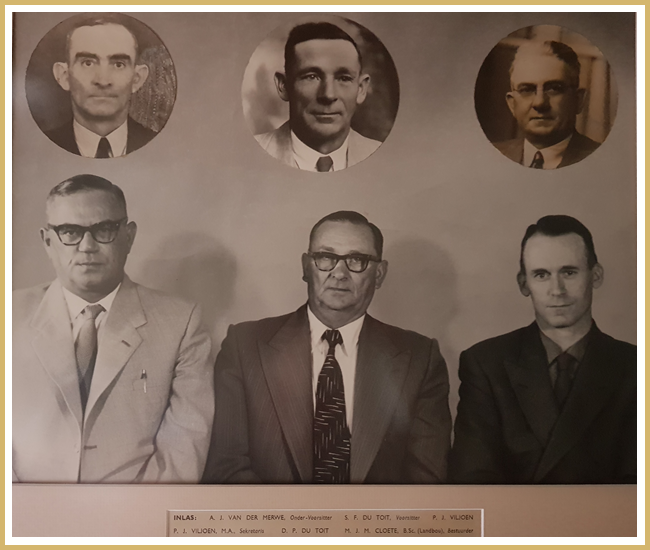-
Late 1700’s
The area consists of four quitrent farms - Aan de Bosjesmansvallei, De Breederivier, Slanghoek and Eendracht – where mixed agriculture takes place. As the community expands, the farms are subdivided. Besides livestock, grains and fruit trees, vineyards are also established of which the farmers make their own wines.
-
1949
Waboomsrivier Winery is founded by 16 farmers from the Breërivier area who all share a vision of producing high quality wines. No time is wasted in purchasing a portion of Kleinberg farm and commissioning the brothers De Kock to build a cellar – at a cost of R110 000.
-
1950
Winemaker Mynhardus Jacobus Marais Cloete receives a total of 4148 tons of grapes during the winery’s first harvest. Initially money was scarce and electricity was deemed a luxury. The 22 members took turns to lend their tractors for powering the cellar machinery.
-
1954
Cloete is granted permission by the board of directors to procure wood, an automatic wine pump and other accessories for the cellar to achieve their goal of high quality wine production. Cloete was famous for experimenting, and his objective was to find a way to extract the cleanest juice possible from the grapes.
-
1956
Cloete designs his popular drainer made of wood. This plays a vital role in enhancing wine quality and results in a considerable saving on labour, not only at Waboomrivier Winery but throughout the industry. It became known as the Cloete drainer or separator. Other inventions by Cloete includes a special tank for the fermenting of quality red wines and a quick fermenter for the fermentation of husks for distilling.
-
1969
The building of a new pressing cellar kicks of under Cloete’s vigilant eye. Over time a quick fermenter and special fermenting tank for the production of quality red wines is added.
-
1970
Waboomsrivier Winery celebrates 21 years of existence with a soirée at Goudini Spa. During that year the cellar pressed 10 797 tons of grapes.
-
1977
An advertisement in Worcester Standard (the local newspaper) offers bottled wine for sale – a first for Waboomsrivier Winery.
-
1978
The board of directors gets permission from KWV to use the flower of the Wagenboom on the wine label. The protea logo used to be one of KWV’s registered trademarks.
-
1979
The first wine maturation barrels come into use.
-
1998
Elevated red wine tanks, designed by Pera Pellenc, is introduced at the cellar.
-
2004
Revolutionary French Flash Denté technology is installed at Waboomsrivier Winery. In short, the grapes are treated with heat and then cooled off immediately by pressure reduction. It not only improves the quality of wine, but also enables the cellar team to adapt their wines to consumer requirements. The result is full round, fruity wines with beautiful colour.
-
2009
Modern GEA Sentrifuges is installed at Waboomsrivier Winery. It not only saves time and labour, but also minimises losses.
-
2010
Due to changes in South African legislation, the old cooperative system at Waboomsrivier Winery is changed to a private company. Members are now shareholders in the cellar.
-
2011
Our flagship wine, Wagenboom Arborea Red, is launched. The maiden vintage (2010) was a special blend of Shiraz, Pinotage and Cabernet Sauvignon. Ever since the best oak matured blend of each year is bottled under the exclusive Wagenboom Arborea Red label.
-
2012
Wine storage capacity is expanded to 4,124 million litres.
-
2014
Waboomsrivier Winery continues their technology driven journey by installing two giant CF 7000 decanters in the cellar – the first of its kind in South Africa. It processes up to 18 tons of grapes per hour and increases the amount of A-grade juice per ton significantly.
-
2019
The winery’s 70th birthday is celebrated in style at Bergland Function Venue. The cellar currently has 15 shareholders and takes in about 18 000 tons of grapes from seventeen farms. The main varieties are Chenin blanc, Pinotage and Colombar.


